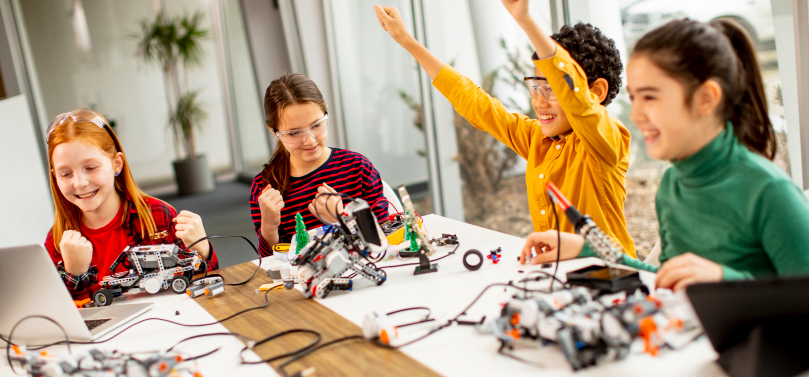In the realm of education, the fields of STEM (Science, Technology, Engineering, and Mathematics) often dominate the conversation, hailed as the pathways to innovation and progress.
However, there's a growing recognition that something vital is missing from this equation: the
Integrating arts into STEM education isn't about diluting the rigor of scientific or technical subjects. Instead, it's about enhancing them by fostering creativity, critical thinking, and holistic understanding. In this blog, we'll explore why creative learning through the integration of arts in STEM is essential for nurturing well-rounded, innovative thinkers.
The Power of Creativity
Integrating arts into STEM education isn't about diluting the rigor of scientific or technical subjects. Instead, it's about enhancing them by fostering creativity, critical thinking, and holistic understanding. In this blog, we'll explore why creative learning through the integration of arts in STEM is essential for nurturing well-rounded, innovative thinkers.
Breaking Down Silos
Traditionally, STEM subjects have been taught in isolation, each existing in its own silo. But in reality, science, technology, engineering, and mathematics are deeply interconnected, and their boundaries blur in the real world. By integrating arts into STEM, we encourage interdisciplinary thinking, mirroring the way problems are approached and solved in the professional world.

Engaging Multiple Intelligences
Not all students learn the same way. Some excel in logical and analytical thinking, while others thrive in visual or kinaesthetic modes of learning. By incorporating arts, we cater to a broader range of intelligences, making STEM subjects more accessible and engaging for a diverse student body.
Cultivating Innovation
Innovation doesn't happen in a vacuum. It requires the ability to think beyond the constraints of existing paradigms, to envision new solutions to old problems. By infusing STEM education with artistic elements, we encourage students to think outside the box, to experiment, and to embrace failure as part of the creative process.
Real-World Relevance
The problems facing the world today are complex and multifaceted, requiring interdisciplinary solutions. By integrating arts into STEM education, we prepare students for the challenges they'll face in the real world, equipping them with the tools they need to collaborate across disciplines and tackle the pressing issues of our time.
Practical Implementation
Integrating arts into STEM education doesn't have to be complicated. It can be as simple as incorporating drawing or painting exercises into a biology lesson, using music to explore mathematical concepts like patterns and sequences, or incorporating theatre and storytelling into a coding workshop.
Developing Critical Thinking Skills
Art encourages students to analyse, interpret, and critique the world around them. By incorporating artistic activities into STEM lessons, educators can help students develop critical thinking skills that are essential for problem-solving and decision-making in both scientific and real-world contexts.
Cultivating Emotional Intelligence
The arts provide a platform for emotional expression and empathy, fostering students' emotional intelligence. By engaging with artistic mediums, students learn to understand and empathize with different perspectives, enhancing their ability to collaborate effectively and communicate with others in diverse settings.
Encouraging Risk-Taking and Resilience
Artistic endeavours often involve experimentation and risk-taking, as there are no definitive right or wrong answers. By encouraging students to explore and embrace failure as a natural part of the creative process, STEAM education promotes resilience and perseverance, crucial qualities for success in any field.
Bridging the Gender Gap
STEM fields have historically been male-dominated, but integrating arts into STEM education can help bridge the gender gap by attracting more female students. Artistic activities offer alternative entry points into STEM subjects, making them more accessible and appealing to a broader range of students, regardless of gender.

Fostering Cultural Appreciation
The arts provide a window into different cultures and perspectives, fostering cultural appreciation and understanding. By incorporating diverse artistic traditions and practices into STEM education, educators can enrich students' learning experiences and prepare them to navigate a globalized world with respect and empathy.
Leveraging Technology and Innovation
In the digital age, technology plays a crucial role in both the arts and sciences. By integrating arts into STEM education, students gain hands-on experience with cutting-edge tools and technologies, from digital design software to virtual reality platforms, preparing them for careers at the forefront of innovation and creativity.
Engaging the Whole Brain
Research has shown that the brain processes information holistically, engaging both the analytical and creative hemispheres. STEAM education harnesses this integrated approach by engaging students' whole brains, resulting in deeper understanding, retention, and application of knowledge across disciplines.
By incorporating these additional points, educators and policymakers can further advocate for the integration of arts into STEM education, recognizing it as a holistic approach that prepares students for success in the 21st century and beyond.
Conclusion
Integrating arts into STEM education isn't about diluting the rigor of scientific disciplines but rather enhancing it with the richness of artistic expression. By embracing STEAM, educators can nurture well-rounded individuals who are not only proficient in technical subjects but also creative, innovative, and empathetic. In doing so, we can unleash the full potential of our students and empower them to shape a brighter future for themselves and generations to come.support@margforyou.com






